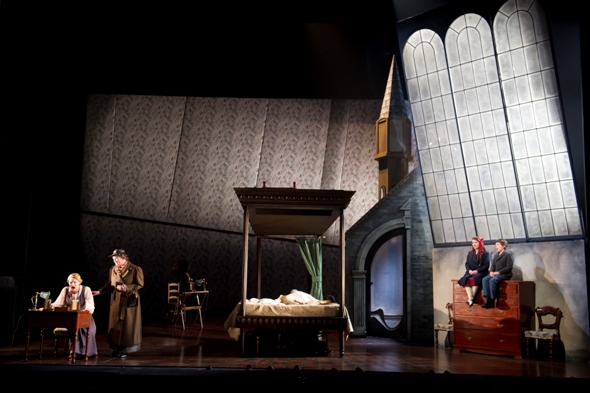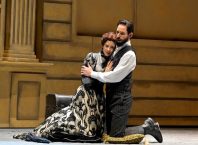“It is a curious story,” begins Benjamin Britten’s opera The Turn of the Screw (1954), not quite summing up the compelling, strange and terrifying story it tells – a story of two spirit-possessed children in a semi-gothic English country house.

The opera is being performed at The Israeli Opera as part of the worldwide celebrations of Britten’s centenary. One of the most important composers of his time, he sent the world of English opera into shock with Peter Grimes, and went on to co-found the English Opera Group. His librettists include some of the beloved writers of the day, such as E.M. Forster and W.H. Auden, and their works are based in turn on the writings of celebrated authors from Shakespeare to Melville.
The English Opera Group toured often and needed a repertoire of small-scale productions to perform, and so Britten began composing operas that would suit their needs, and required only a handful of singers and a small orchestra. Thus chamber opera, at least in its modern sense, was born.
Conductor David Stern returns to the Israel Opera for Turn of the Screw, which he describes as one of the most beautiful examples of musical drama. Britten, he says, was writing colors, seamlessly blending text and music together. A master of orchestration, he spread out the notes as if using not a pen, but a paintbrush. The music, despite the small orchestra, is never too thin.
Britten’s musical structure is perfectly balanced. Each of the two acts is divided into eight scenes, and each scene is a variation on a theme. Miles’ Latin song, “Malo”, with its childlike text and sinister music, becomes a leitmotif that is echoed by the other characters. The letter is another leitmotif – the letter from Miles’ school, the letter the governess writes to the master. It suggests a lack of communication between the characters, and creates a psychological painting.
The Turn of the Screw is so puzzling a text, any work based on it is inevitably an interpretation. In Henry James’ novella, the most crucial question is left open: are the ghosts real or is the governess imagining them? Piper’s libretto, by giving the ghosts voices, makes them more real, more tangible, than those of the original story; and yet, the governess’ words in Act II betray her unstable state of mind: “I feel it, I fear it, worse – imagine it.” Director Alessandro Talevi, who hails from South Africa and is visiting Israel for the first time, worked hard to keep the suspense of the novella palpable in the opera. The governess, for example, can be seen onstage when the ghosts are singing, and so the audience can’t be sure whether the apparitions are real or not. Presenting a theory, Talevi explains, would ruin the genre – he wants to keep the audience guessing and questioning until the very last bar.
The singers that grace the stage in this production know how to color each phrase and allow the music, words and drama to subtly come together. Noa Danon sings the part of the governess, and says that interpreting the role has been a powerful emotional experience. Irish soprano Sinead Mulhern, in her Israeli Opera debut, shares the role with her. Julie Mellor and Na’ama Goldman are excellent in the role of Mrs. Grose, the housekeeper.

The ghost of Peter Quint is portrayed by Robert McPherson and Michael Bennet, who are positively terrifying and display acting skills as well as superb, balanced voices. Israel Opera regulars Anastasia Klevan and Edit Zamir are just as frightening in the role of Miss Jessel, who, in this production, is carrying Quint’s child. The idea of operatic ghosts may sound strange, but Britten’s ghosts manage to sound spooky without being clichéd. Quint’s final monologue, Maestro Stern points out, connects to the tradition of Gregorian chant, which in turn was influenced by Jewish cantorial music.
An important milestone in English opera, Turn of the Screw keeps an age-old tradition alive: boy singers. The two young musicians who share the role of Miles are appearing in Israel for the first time, but are both veterans of several respected European stages. The part of Flora is sung by promising Israeli soprani Shira Patshornik and Yarden Sussholz.
The staging is clean and traditional. The action takes place in the nursery, and the intimate setting allows the audience to imagine themselves inside the scene. The ghosts blend easily, almost casually, into the world of the living. The lighting plays with the mind’s eye, making the furniture cast shadows around the room and emphasizing the governess’ fears.
While The Turn of the Screw might not fall under the category of casual entertainment, it is certainly a spellbinding work, especially with the Israel Opera’s worthy presentation. Catch the final performances of The Turn of the Screw at the Israel Opera, Thursday February 21 and Friday February 22. Tickets may be ordered online, or call: 03-6927777.
If you can’t make it to the Israel Opera’s production, check out the recording made by the original cast and conducted by the composer, available on CD.






You are brave to have watched this opera. I take my hat off to you.
Comments are closed.